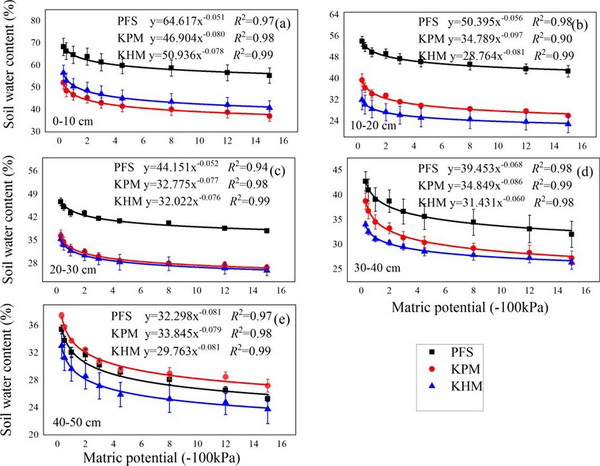Soil water retention capacity is an essential component of the land surface processes and hydrological cycles. Although the effect of grassland degradation on soil water retention capacity have been well documented, few studies have focused on how soil hydrological properties vary between different vegetation types on the Qinghai-Tibet Plateau (QTP). This study selected three vegetation types: Potentilla fruticosa shrub (PFS), Kobresia pygmaca meadow (KPM), and Kobresia humilis meadow (KHM), and aimed to explore the variations and factors controlling soil water retention capacity across the three types. Results showed that the soil water retention capacity was higher in PFS than in KPM and KHM across 0–40 cm, whereas the 0–30 cm plant available water content was much lower in PFS than in KPM and KHM. Meanwhile, the soil properties within the different soil layers varied significantly between vegetation types. The 0–10 cm clay and silt contents were significantly higher in PFS than in the other two vegetation types, whereas the soil bulk density (BD) was lower in PFS than in KHM and KPM. Furthermore, the 0–50 cm soil capillary porosity (CP) was significantly higher in PFS than in KPM and KHM, except at 0–10 cm. Besides, the 0–10 cm soil organic matter (SOM) was significantly higher in KPM than in PFS and KHM, owing to its highest root biomass. Overall, the soil water retention capacity was most strongly influenced by CP, followed by BD, TP, SOM and root biomass, whereas the soil non-capillary porosity and soil particle size distribution exerted no significant impact on soil water retention capacity. Our results suggested that the alpine shrub had a stronger soil water retention capacity than the alpine meadow.

This result was published in Ecological Indicators with the title of “Alpine shrub had a stronger soil water retention capacity than the alpine meadow on the northeastern Qinghai-Tibetan Plateau”.
The link below will guide you to the reading:
